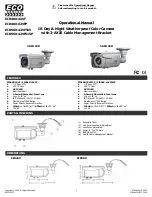
V1.02
Thom Hogan’s Complete Guide to the Nikon D300
Page 41
shots. Well, the problem is that you’re telling the camera
to amplify the data (
Active D-Lighting
), amplify the data
(higher ISO value), amplify the data (underexposure), and
apply a dark pattern correction to it (
Long exp. NR
). Ever
wonder how much you can get away with? Well, not that
much ;~). Actually, Nikon responded to the initial
complaints and quickly updated the firmware (to
A1.02
)
to reduce the specific problem that people were writing
about, but it’s still possible to turn on so much
amplification and image manipulation that you can reveal
artifacts that mimic the underlying row and column
structure of the photosites. I’ll have some specific
recommendations later in the eBook, but trying to get an
all-automatic, see-into-the-dark setting invoked is one that
I recommend avoiding, mainly because it doesn’t work. It
wouldn’t work on other cameras, either, if you try to do
all those things to the underlying pixel values.
Bottom line:
There are limits to what any camera can do,
and when you push beyond them you get less than
acceptable results. The D300 is no different in this than
other DSLRs. But in this particular case, the primary
culprit was Automatic ISO coupled with repeated long
exposures treated with
Long exp. NR
. Nikon made
firmware adjustments that eradicated the problem most
people reported.
If you were to believe the posts in some Internet forums, the
D300 is a terrible camera with a defective design and not
worth the money. I completely disagree. If I were told I could
only use a D300 for the next two years, it wouldn’t upset me.
Handled properly, it can produce quite stunning images.
Don’t believe me? Well, take a look at the image on the next
page. Moreover, the D300 does basically the same things the
D2x can do for a much lower price.
Funny thing is,
every
DSLR camera that gets introduced these
days seems to gets its share of criticism on the Internet.
















































